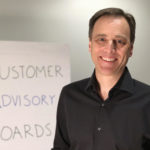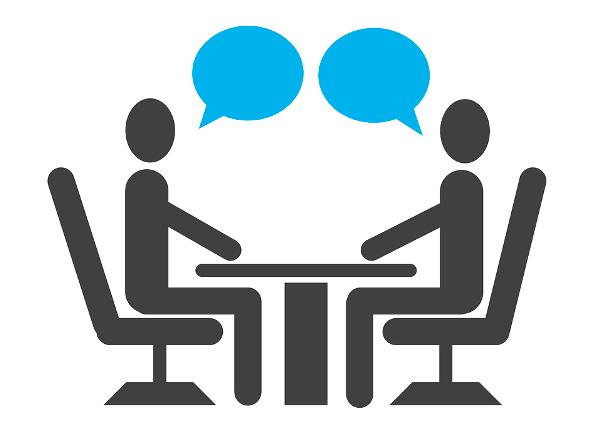Conducting Customer Advisory Board member interviews can be intimidating. As a professional Customer Advisory Board architect and facilitator, I’ve interviewed hundreds of C-suite executives. Here are 4 tips that will improve the ROI of your own efforts.
Before I dive in, I should clarify that the type of interview I’m talking about is not a customer “win-loss” or “lead generation” type of interview.
When engaging C-suite decision makers, the interview usually focuses on the future of their business (not yours). Sometimes, the objective of the interview is to understand their vision and business drivers so you can discover how, when, and where your company can assist them in achieving their future business goals. Other times, the objective is to dig into their buying process (as opposed to your sales process) so you can better understand how they make decisions. In both cases, this type of interview is akin to market research, not product definition or sales development.
1) Pretend your are an investigative journalist
While you and your team will have created an interview guide of carefully selected questions, the interview may not go as you planned. Therefore, the interviewer needs to be nimble and flexible. The interview guide is not a straight-jacket. You want to go where the conversation takes you (albeit, within the parameters of the objective of your interview program).
That means, when the customer responds to your question with something you don’t understand, you should ask a follow-up question. If they say something that surprises you, take a moment to dig deeper. Don’t just say “okay” and move on. Be curious and conversational. Sometimes, the most valuable pearls come from responses you don’t expect.
This also means that if you have only 20 minutes to conduct your interview, you may not get through all of your questions. That’s okay. As an investigative journalist, you need to follow the story. Don’t worry about dotting all your i’s or crossing all your t’s. If your interview is part of your CAB, you will have other opportunities to continue this dialog in person at the CAB meeting. Balancing the desire to get through the interview guide against the quality (or depth) of the answers is a fine line you will learn how to navigate.
2) Learn how to listen
Human ego gets in the way of so many conversations. The able-minded interviewer needs to be able to separate his or her ego from the customer’s response. Examples of ego getting in the way sometimes look like this:
* Customers disagreeing with the question (or your implied bias). In response, you find yourself defending the question.
* Customers sharing an answer that is complicated or different from what you expect. Your response is to either ignore their response, or to rewrite their response to support the conclusion you want.
* Customers offering an answer that you don’t understand. Instead of asking a clarifying question, you nod your head and move forward. Fear of appearing stupid or naive, rather than curiosity drives your action.
Learn how to become comfortable in the technique of active listening. This takes practice. Look for opportunities at work and in your personal life to interview others. The more you do it, the more at ease you will be. A relaxed interviewer is ALWAYS more effective than a nervous one.
3) Write your notes for others, not yourself
When I coach marketers on how to become more effective interviewers, they show me their notes from a recent 1:1 they had with a customer. Their notes are choppy, written in short-hand or bullet points. I read them and have no idea what was discussed and what really came out of the interview. This is often because the interviewer knows what they are talking about and feels they don’t need to explain fully in their notes. When this happens, the interview reports quickly lose their value.
Instead of writing the reports for your own records, write them for your teammates who were not on the call with you. Any reader should be able to understand your notes and feel as if they were in the room with you. I’ve found that when interviewers do this, their write-ups make a lot more sense.
My write-ups follow this general flow:
1 – Provide the name, title, etc. of the person being interviewed. Also, include the reason why this person is being interviewed.
2 – I include my “facilitator overview notes” in italics as the introduction to my interview report. However, this is written last. I only write it after I have completed the meat of the report. In this opening paragraph, I summarize the key take-aways from the interview, including any insights (spoken or unspoken) I gleaned from the conversation. This is critically important to establishing the context for the key-takeaways that follow in the report.
3 – In response to each question, I try to capture as much verbatim responses as possible — especially when the customer says something surprising. Capturing their own words can be revealing. And, it makes the report easy to read. These responses are always included in quotation marks.
(Sidenote: What about audiotaping the interview or capturing notes in a stenographer style? If the customer agrees to be audiotaped, that’s fine. But, don’t expect your executives to listen to hours of interview tapes. They want the gist in a shareable, easily digestible format. That will be your write-up. As far as stenographer style notes? Nobody will read those. A good interviewer needs to be able to distill a 20 minute (or longer) conversation into a meaningful output.)
4 – My reports are a combination of verbatim customer quotes and my own paraphrasing of each discussion question. To know which style to use, and where, comes with practice. My typical interview report is between 3 – 4 pages long.
4) Be disciplined in managing the process
After conducting a 20 minute interview, I leave the next hour free so I can reflect on the conversation and write my final report. During the call, I will have captured a streamline of conversation. My spelling is atrocious. It doesn’t matter. I’ve learned how to jot notes and pay attention at the same time. But my notes won’t capture everything. And these initial notes will be unreadable to anyone else. That’s why I need some quiet time afterwards. I replay the interview in my head and clean up my notes in real time. (FYI – If I delay in doing this, my ability to retain details of the conversation begins to fade. It’s best to do this quickly.)
Then I place the notes on a share drive and invite the team to review and share with others.
After a critical mass of interviews are completed, I then create an executive summary of the general trends and responses I’ve collected. I include “things that I expected” as well as “things that surprised me”.
This process is highly valuable and extremely effective. But it takes practice, patience, and perseverance.
Learn more
How to interview C-suite customers is a topic included in my CAB Masterclass.

Mike Gospe leads KickStart’s Customer Advisory Board practice
Mike Gospe is a professional CAB facilitator for B2B companies, and he leads KickStart Alliance‘s CAB practice. Since 2002, he has architected and facilitated more than 100 successful CAB engagements. To learn more about his tools, “how to” books, and custom engagements, please visit his CAB Resource Center or contact Mike.

